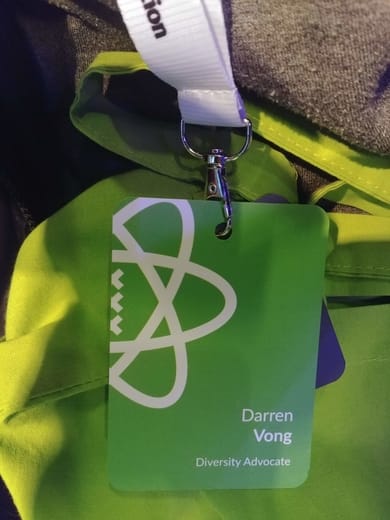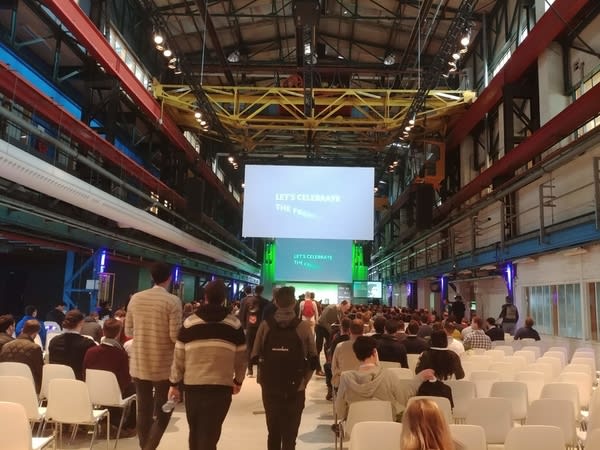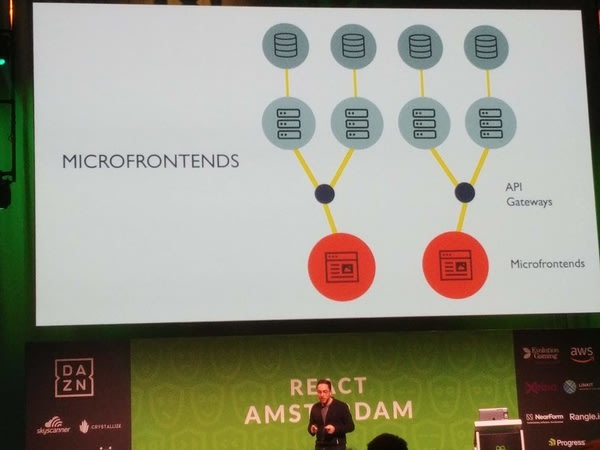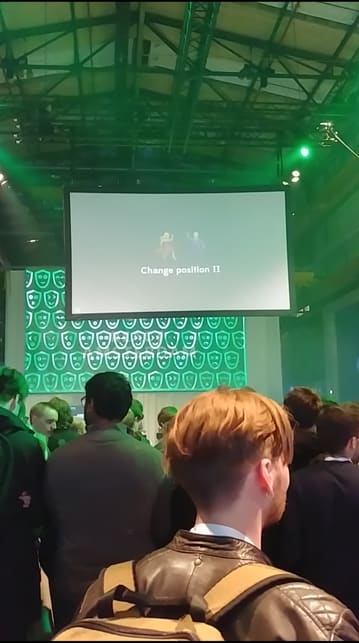Attending a conference for the first time, especially on your own, can seem like a daunting experience. But the benefits of going to one, such as finding new ideas and inspirations from leaders in your field, amongst others detailed in this article, makes it worthwhile if you want to level up professionally and technically.
Normally, the main barrier to attending a conference is the dear ticket cost. However, thanks to a successful application to the diversity scholarships offered by React Amsterdam, I was able attend the event itself for free!
Applying for the scholarship was easily one of the best decisions I’ve made this year, so if you are eligible in one of their upcoming sister conferences, I highly recommend going for it as the process only involved filling in a short application form.
The following is an account of my first experience attending React Amsterdam, in the perspective of a solo attendee. In each aspect of the conference, where appropriate, I have left tips of things I have learnt from this experience.
I hope this will help if you are looking to go in future years, and encourages you to do so even if you have to go on your own!
Slack channels
As a first time, solo attendee of the conference, the official React Amsterdam Slack was an invaluable way to keep up to date with the event and to connect with other attendees. Live updates of the events were provided there throughout, and the official organisers were quick to respond to any questions people had.
Its adoption seemed natural as most developers are likely to be using the platform for their day-to-day communication at work already. This was evident as there were messages sent every day throughout the event, where attendees were organising informal hangouts and meet-ups.
Personally, I was able to meet developers from Australia and Denmark just by dropping out an invitational message for others who attended on their own to hang out over lunch. On another occasion, I met a couple of developers and recruiters from Canada for dinner having looked out for a message in the same spirit as the one I sent.
Overall, I think this made meeting other attendees easier, which meant the thought of going by yourself was a lot less daunting. It has certainly made the experience more fun for me!
Tip 1: If you are attending the next one on your own, join the official Slack and be proactive in it! This can be either arranging something or responding to ideas others put up.
Getting to the conference
The Kromhouthal, where React Amsterdam took place, is situated in North Amsterdam, right next to the IJ river. The location was easily accessible - for me, it was a 20 minutes walk away from a nearby hostel I stayed in.
As a dedicated ferry shuttle service (runs between Amsterdam Centraal and the venue) were organised by the conference, the venue can be easily reached as long you were based near a metro or tram stop that can get you back to Amsterdam Centraal, thanks to the brilliant public transport network in the city. If you are a confident cyclist, you can even cycle there as bikes are readily available for rental.
Having said that, I remember reading from the conference Slack that there were delays due to some of the ferries being full. The other thing to bear in mind was the length of the queue:
Liquid error: internal
Even though I was there around 30 minutes before the conference opening, I still had to wait around 10 minutes before I got to the registration desk. I am sure this is something the conference will improve on in the future.
Tip 2: Take the earlier shuttle, or use the free public ferry service and walk for about 20 minutes from the Veer Buiksloterweg ferry terminal, to ensure you are on time for the first talk.
The conference programme
After completing registration, I was given a name badge that, frankly, I had forgotten what I told the conference to write in the description of who I am:
Apart from the name badge, I was also given a programmes guide for the day with a React Amsterdam branded goodie bag filled with React styled swags, which included this amazingly shiny green mug:
Liquid error: internal
Personal disclaimer: I love the mug so much that it’s now become my office mug over my office branded ones!
As I walked past the registration desk, the interior of the building gradually revealed itself. It was clear that the building was repurposed for events like the conference, but at the same time, kept its charm of a former warehouse.
With two parallel tracks (General and React Native Track) of brilliant talks happening at the same time, it was difficult to choose which ones to go to at times! Throughout the conference, I was constantly switching between the two tracks to try and get the best of both worlds. Here are some of my favourites of the ones I went to:
Kent C. Dodds - Requisite React
If anyone was looking for good reasons to come to React Amsterdam, this opening talk was a pretty strong response. In this talk, Kent went through one of the key ways to level up as a React developer (or just in general) - get a better understanding of the abstractions we use everyday!
Moving from a personal example where he fixed his tap by understanding what went on underneath, to implementing code similar to those under the abstraction of the work-in-progress Suspense feature, it demonstrated well how we can reduce our code by having a better grasp of the things under the hood.
My favourite thing he mentioned has to be this:
Liquid error: internal
Console-logging JSX seemed such an obvious thing to do in hindsight, but it’s definitely something I overlooked when learning React! Without ruining the talk too much, by doing so and following some other abstractions he explained later, it immediately made so much sense as to why constructs like if-statements aren’t allowed in JSX interpolations.
Siddharth Kshetrapal - Refactoring React
For those who are after solid tips on how to spot code smells in their existing React codebase, Sid had you covered in this 30 minutes of pure live coding brilliance. Tips covered include:
- Having a minimal API surface area such that developers only have to learn well-known behaviours to use a component;
- Follow the Single Responsibility Principle, where a single component should do its one job well and delegate the rest to other components;
- Avoid feature envy - i.e. when the parent component has too much interests in a feature that should be written inside a child component instead…
… and many more! Especially for those who are purely interested in the code and less on traditional presentations, I highly recommend giving this a watch!
Max Stoiber - Tech Regrets at Spectrum
This was a reflective talk regarding the regrets on some of the technology choices made whilst Max was building Spectrum, a real-time messaging app for the developer community. We all make mistakes at the end of the day, and in my opinion, the brutally honest manner in which he shared the lessons learnt was quite refreshing.
My personal favourite of the regret he shared was not using Next.js, as he relatably opened with “server-side rendering. How hard can that be? I’m going to build my own server-side rendering (SSR) server!”. He soon discovered that it’s extremely hard to get right and had, in fact, struggled to have a reliable server environment for two years.
Max then followed up by saying that he guarantees nobody else knows more about SSR than Tim Neutkens, and so recommends anyone who needs SSR to use it rather than reinventing the wheel (badly). Coming from a successful startup founder who has been acquired by GitHub, I’ll certainly think twice in future projects that may need SSR and refer anyone to Max’s talk if they think building their own SSR solution is easy!
Max Gallo - Scaling Applications with Microfrontends
In this high-octane talk, Max covered the interesting concept where the idea of microservices in the backend is applied to the frontend to avoid a monolith in DAZN’s web app. Each microfrontend is a Single Page Application (SPA), which according to Max, proved to be a good way to get developers up and running quickly, as knowledge of HTML, CSS and JavaScript would be sufficient to start building.
The concept also seemed to allow their teams to properly share out the workload and avoid having too much communication overhead, as the only common interface they have to agree on is the bootstrap layer. This, in turn, led to autonomy and empowered developers to try new things and innovate. In doing so, they are likely to be happier and thus stick around, says Max. I couldn't agree more!
Despite having heard of microservices before, microfrontends was (and still is!) a completely new concept for me. It is this kind of talk that you want to attend in a conference to spark new ideas to take away and keep up with the latest trend.
For more detailed descriptions of what went on in the General Track talks (and the event overall), check out this blog post written by Eric Bishard, a fellow attendee who also ran the Progress booth. Or for the full experience, you can watch talks from both tracks using the following links:
General Track: https://www.youtube.com/watch?v=4KfAS3zrvX8
React Native Track: https://www.youtube.com/watch?v=NCLkLCvpwm4
Overall, I enjoyed the format of how the talks were arranged, as there was a coffee break after every two talks, which gave attendees plenty of time to absorb the information. It also provided opportunities to network, check out the sponsor’s booths to win more cool swags (like the fun beach balls you get from Skyscanner) and even the chance to get advice on your projects from experts in specific areas of React.
Food
As a night owl who had woken up since 6.30am, I immediately went for the coffee in front of me to stock up on the much needed caffeine rush. In terms of food for breakfast, there were plenty of pastry snacks on offer, but I went for a more hearty oat and yoghurt pot instead, which sufficiently fuelled me for the first talk of the day.
Lunch was also well organised, as the distribution of food was split into multiple tables to avoid a further build up of already long queues. There were curry options served with rice for vegetarians, omnivores and anyone with special dietary requirements.
The only downside was probably the evening food trucks, as they were quickly running out of food by the time I reached the front of the queue; it was made more frustrating by the fact that I’ve queued for over 30 minutes effectively for nothing.
Bearing in mind that a food truck is limited in size, and thus how much food they can stock up, hopefully the conference can solve this issue by arranging to have more food trucks in the future.
Tip 3: Go to the food truck in the last coffee break, rather than waiting until the end, to beat the queue of hungry people!
The after party
From this point onwards, this is the optional part of the conference. Since I didn’t plan to do anything else in the evening anyway, and the intention was for us to have fun after a day of learning new things (or work, i.e. promoting the work-play balance), I decided to stick around and see what it’s about.
The party started off with some mix of electronic and techno music, accompanied with snacks and this local, React-themed blond beer:
This set the scene which made everyone more relaxed, and the snacks were probably just enough to keep those of us who did not get anything from the food truck happy!
The highlight of the after party programme has to be “The Smartphone Orchestra - The Social Sorting Experiment” game. Because of the limited space available, only around 100 people could take part.
The game was fairly accurate to the title - a social experiment. Participants had to go on a dedicated website using their phone, and follow the instructions on the screen. The instructions were clearly aiming to encourage us to interact with each other, as it ranged from talking to your neighbours, to staring and rating the attractiveness of your neighbours’ ears!
When the participants weren’t talking to each other, they had to fill in some questionnaire which ultimately fed data into the game’s machine learning algorithm. Given that only a brief set of questions were asked, the results at the end, such as determining the participant’s height in order, were surprisingly accurate!
Due to the cryptic and strange way the game was initially introduced by the DJ before it started, I (and many others) ended up stood around and watched the game happened. I low-key wished I had taken part, as it looked like a fun way to break the ice and get talking with new people.
The event carried on until 9.30pm with some cool laser light audiovisual performance from Nick Verstand and Boris Acket, followed by more live coded music. This created a friendly and chilled atmosphere.
Several groups were stood in the shape of the Pac-Man Rule which encouraged solo attendees like myself to walk up and start a conversation, and if they weren’t, most people were generally receptive to a chat. So, if you are coming to the next one, there’s no need to be afraid to come on your own.
Tour day
For me, this is what made React Amsterdam unique, as I don’t remember reading many other conferences (whilst I was researching ones to attend) including an extended programme that helps you explore the city you are in and socialise with other attendees. It’s these extra effort that the conference put in which helps to foster a great community.
There were two options with multiple time slots throughout the day: attendees could either explore Amsterdam on foot with a guided walking tour, or take advantage of the canals by seeing the city on a scenic guided boat tour.
Both options last around 90 minutes, but as I’ve walked around Amsterdam on foot before, and taking the boat tour on its own won’t be cheap, I jumped on the opportunity to join one of them. Although it wasn’t so warm on the day, it was still a great decision as the sky were generally clear on the day. This is what I managed to catch:
Liquid error: internal
Personal regrets
Attending React Amsterdam has been an awesome experience! The conference has certainly left me energised and inspired with new ideas - I can’t wait to try them out in my current and upcoming projects!
Having said that, there are always things I wish I had done, which include:
- Remember, and more importantly, pick up more courage to take selfies with the new people I’ve met. For someone who seems to shy away from the camera, this is a tricky one for me, but definitely one to work on! The memory when looking back at events like this will be worth it!
- Talk to speakers after their talks! Most of them were friendly to connect and chat, and so it would have been a great opportunity to follow up with questions about their talk that may be relevant with my current projects.
- This one was slightly out of my control - as I really couldn’t afford to buy a ticket myself - but attend one of the pre-conference workshops! Maybe this is something the diversity scholarship can help in the future.
React Amsterdam 2020
The event is due to return on 16th and 17th April in 2020, which means it will be a two-day conference for the first time! I have really enjoyed working with React so far, and as the core team continues to improve the framework with features like React Suspense, I am excited to see its other plans for the year. So I certainly hope I will get to come back next year, perhaps with the help of another diversity scholarship.












Oldest comments (0)